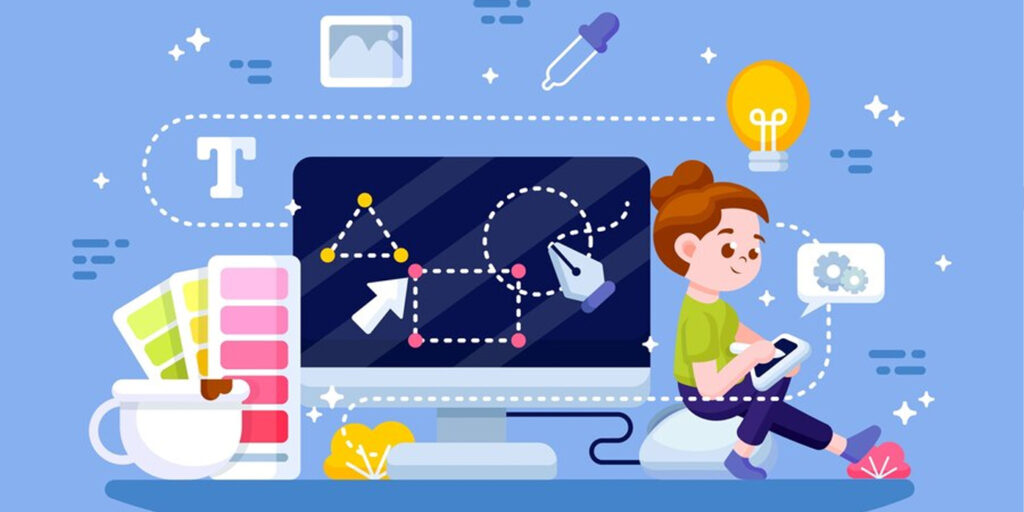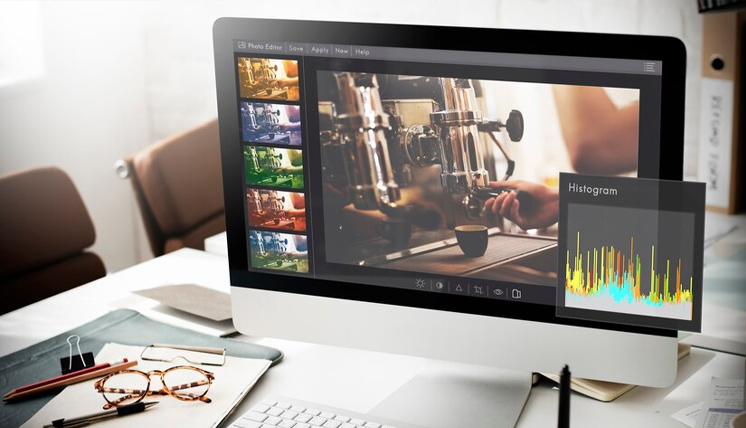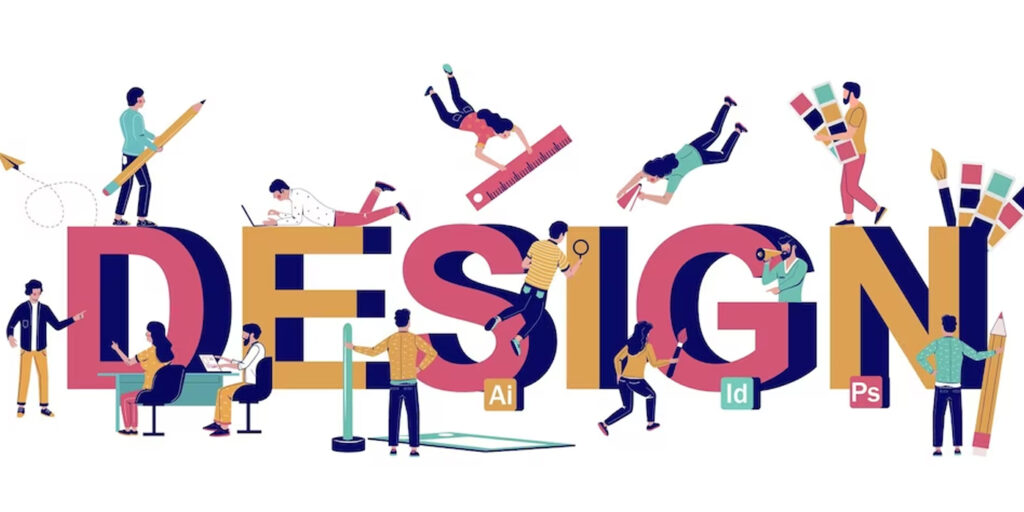How to Learn Graphic Design in 2024: A Complete Guide

Graphic design is the process of visually communicating ideas using images, typography, and layouts. It is all about combining creativity and technology to produce eye-catching designs that successfully transmit messages. To begin learning graphic design, start with basic principles like color theory, typography, and composition.
Use design software such as Adobe Photoshop, Illustrator, or Canva to practice producing visuals. Understand how to organize pieces in your designs using principles such as balance, contrast, and hierarchy. Look for inspiration by looking at other designers’ work to learn new styles and techniques.
Improve your talents and develop effective designs by practicing constantly, seeking criticism, and continuing to learn. Remember that graphic design is both an art or a skill that improves with practice. Remember that graphic design is both an art and a skill that improve with time and effort. Immerse yourself in the realm of design, experiment freely, and allow your creativity to grow.
Understanding Design Principles in Graphic Design
Understanding design principles is essential for everyone working in the design industry, whether it is graphic design, web design, interior design, or any other kind of creative expression. Design principles are guidelines that help designers decide how to properly organize pieces inside a composition.

Composition
Composition in graphic design is similar to putting the components to make a visually appealing and successful design. It entails arranging components such as text, graphics, and shapes on a page or screen in a way that draws attention and communicates a message clearly. Designers use balance, hierarchy, alignment, and closeness to create harmonious layouts. They use symmetry, asymmetry, and the rule of thirds to govern their compositions. Designers create aesthetically beautiful, understandable, and memorable ideas by carefully organizing elements and taking into account visual relationships.
Typography
Typography is the art and skill of arranging type so that written language seems easy to read and visually beautiful when exhibited. It entails choosing typefaces, font sizes, line lengths, line spacing, and letter spacing to produce visually pleasing and readable text. Typography appears in a variety of media, including books, newspapers, magazines, websites, and advertisements.
Color Theory
Color theory is a fundamental idea in art and design that explains how colors interact with one another and how they can be used to produce visually appealing compositions. It includes rules and guidelines to help artists and designers make educated choices regarding color selection, contrast, harmony, and application in their work. You can follow our link to learn about IELTS speaking blog.
Layout
Layout design is the process of organizing visual elements on a page or screen in an aesthetically pleasing and functional order. This could apply to a variety of mediums, including websites, printed products such as brochures or posters, application user interfaces, and more. Effective layout design combines design principles, user experience, and project-specific constraints.
Visual Hierarchy
Visual hierarchy is the organization and prioritizing of layout components in order to direct the viewer’s attention and successfully express the most relevant information. It facilitates user navigation across the content by providing information in an orderly and intuitive manner.
Essential Tools and Software in Graphic Design
When it comes to design work, basic tools and software are critical. Adobe Illustrator is excellent for generating vector graphics, including logos and illustrations. Adobe Photoshop is the best tool for picture editing and digital artwork creation. CorelDRAW is another excellent application for vector graphics and drawing, with special capabilities for designers. Adobe InDesign excels at layout design for print or digital publications, allowing you to easily produce gorgeous texts, brochures, and magazines. These apps offer artists a comprehensive arsenal for bringing their creative thoughts to life with precision and speed.
Adobe Creative Suite (Photoshop, Illustrator, InDesign)
Adobe Creative Suite refers to a collection of design, editing, and publishing software developed by Adobe Systems. The suite includes popular programs such as Photoshop, Illustrator, and InDesign, among others.


- Adobe Photoshop
Photoshop is an advanced raster graphics editor for editing and altering digital images. It is commonly used by photographers, graphic designers, web designers, and artists for picture editing, compositing, and creating digital artwork.
- Adobe Illustrator
Illustrator is a vector graphics editor used to create illustrations, logos, icons, diagrams, and other sorts of artwork that must be scalable without sacrificing quality. It defines objects using mathematical equations, making it suitable for designing simple, flexible designs.
- Adobe InDesign
InDesign is a desktop publishing software that allows you to produce print and digital publications such as magazines, newspapers, books, brochures, and interactive Documents. It includes capabilities for layout design, typography, and organizing multi-page documents, making it a must-have for professional designers in publishing.
Developing Technical Skills on Graphic Design
Developing technical skills, particularly in software like Adobe Creative Suite or another field, takes a combination of practice, study, and testing.
Image Editing Techniques
Image editing techniques in graphic design encompass a wide range of ways and tools for improving, modifying, or transforming pictures to achieve specific creative goals.
Cropping is the process of cutting an image’s borders to remove undesirable elements or to focus on a certain subject. It improves composition and eliminates distractions.
Resizing alters the proportions of an image, making it larger or smaller. It’s useful for arranging photographs in specific places or optimizing them for different devices.
Vector Graphics in Graphic Design
Vector graphics in graphic design use mathematical equations to generate scalable pictures. These graphics are made up of routes delineated by points, lines, and curves, allowing for smooth and accurate shapes. They are perfect for logos, images, and design that need flexibility given that they can be adjusted without sacrificing quality. Vector graphics are created and altered with tools such as Adobe Illustrator.

Digital Illustration
Digital illustration is the creation of artwork with digital instruments like computers, tablets, and software. Artists create captivating pictures through techniques such as drawing, painting, and digital image manipulation. It enables exact control over colors, shapes, and textures, resulting in limitless creative possibilities.
Exploring Specialized Areas
Exploring specialized areas entails digging into particular fields or themes to have a better grasp and skill. It frequently comprises intensive research, experimentation, and collaboration in certain fields such as quantum computing, biology, or sustainable building. People that immerse themselves in these areas gain unique insights, generate novel solutions, and contribute to advances in their careers. This exploration creates a dynamic flow of ideas, promotes collaborative methods, and cultivates a community of specialists committed to pushing limits of knowledge and creativity in their chosen fields.
Web Design
A web design shot is basically a picture or snapshot showing how a website looks. It gives you a quick look at things like the layout, colors, fonts, and any images or graphics used on the site. It’s like a sneak peek to see if you like the design before actually visiting the website. People often use web design shots to share and showcase website designs with others.


Branding and Identity Design
Branding and identity design are all about building a distinct and identifiable image for a company or product. It include creating logos, color schemes, fonts, and other visual elements that convey the brand’s personality and ideals. Essentially, it is about creating a visual identity that differentiates the company from others and makes it memorable for customers. Good branding and identity design enable businesses to communicate who they are and what they stand for, fostering trust and loyalty among their target audience. It’s like giving a brand its own unique personality and flair.
Print Design
Print design entails producing visual elements for physical media such as paper or fabric. It entails creating brochures, posters, and packaging utilizing font, graphics, and layout strategies that successfully convey information.
Learning Resources and Courses for Graphic Design
Learning resources and courses are tools and instructional materials that assist people gain new knowledge or abilities. These resources can take many different forms, including textbooks, online tutorials, films, and interactive modules. Courses are structured learning experiences, frequently guided by professors, that study specific topics or themes in depth. Whether through traditional classrooms or online platforms, these resources allow individuals to broaden their awareness and expertise in a variety of subjects, empowering them to pursue personal or professional development objectives.
- Online Tutorials and Courses
These are lessons that you can access via the internet to master new skills. They frequently contain videos or interactive exercises to help you clarify the content.
- Books and Publications
These are written materials, such as books or articles, that provide knowledge on a variety of topics. You can read them to learn about specific topics or for ideas and inspiration.
- Graphic Design Communities and Forums
These are online communities where people who are interested in graphic design may discuss and share ideas. You can ask questions, seek help, and learn from fellow designers.
- Mentorship Programs:
These are programs where someone with experience in a given industry assists and advises someone who is just starting out. They can guide you, answer your questions, or help you in achieving your goals.
Building a Portfolio in Graphic Design
Creating a portfolio entails selecting and presenting projects that emphasize your abilities and flair. Creating a personal brand promotes consistency and professionalism throughout your portfolio. Using online portfolio platforms increases visibility and accessibility for potential clients or employers. Networking and collaborating with peers and industry professionals can provide useful chances and feedback for portfolio development. By following these procedures, you can effectively market yourself and attract possibilities in your chosen area.

Selecting and Showcasing Projects is Crucial in Graphic Design
Consider your talents, interests, and expertise to identify the types of initiatives you want to highlight. Consider what makes you special and distinguishes you from others.
Choose tasks that best reflect your abilities and accomplishments. Choose a variety of projects that demonstrate different talents, industries, and approaches, if possible.
Showcase your contributions and successes in each project. Include particular measurements, outcomes, or awards to show tangible proof of your accomplishments.
Creating a Personal Brand
Determine your desired reputation and how others will perceive you. Consider how your values, passions, and strengths relate to your professional identity.
Maintain consistency across all of your online and offline platforms, including your portfolio, social media profiles, résumé, and networking activities. Use consistent language, images, and tone to strengthen your brand.
Maintain honest and authentic interactions and exchanges. Allow your personality to shine through, highlighting your distinct perspective and voice.
Clearly express the value you provide to employers, clients, and partners. Highlight what makes you unique and why others should choose to work with you.
Online Portfolio Platforms
Choose the online portfolio platform that best meets your needs and ambitions. Popular choices include Behance, Dribbble, WordPress, Squarespace, and Adobe Portfolio.
Personalize your portfolio to suit your brand and successfully present your work. Customize layouts, colors, fonts, and other design aspects to make the material more unified and visually appealing.
Conclustion
In conclusion, building a strong personal brand, showcasing your work effectively, networking, and staying updated on industry trends are essential steps for success in graphic design. By following the strategies outlined in this guide, you can enhance your visibility, attract opportunities, and establish yourself as a reputable professional in the field.
- Recap of Key Points
Curate your portfolio to highlight your abilities and accomplishments, and create an engaging story for each project.
Define your brand’s identity, ensure consistency across all platforms, and communicate your distinct value offer.
Select a platform that meets your requirements, tailor your portfolio for visual impact, optimise for mobile, and add clear contact information.
Attend industry events, use social media, join online communities, and provide value to form significant connections and collaborations.
- Future Trends in Graphic Design
As technology and design methods advance, graphic design is expected to embrace new trends and innovations. Some future trends can include:
Increased emphasis on ecologically friendly design approaches and materials.
Integrating AR and VR technologies into graphic design to create immersive experiences.
Using data-driven design to tell captivating visual stories.
Continued emphasis on minimalist and simple design aesthetics for clarity and usability.
Increasing the use of animation and motion graphics to engage people across several digital platforms.



